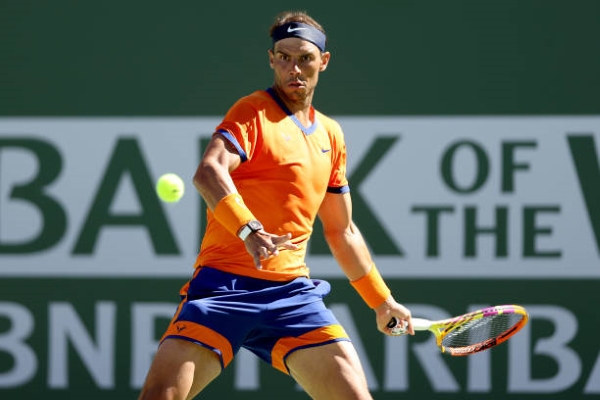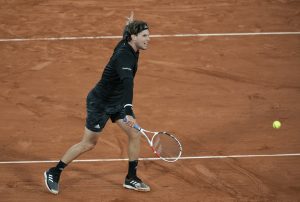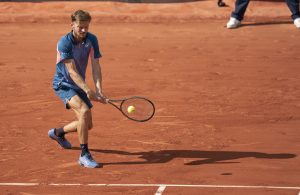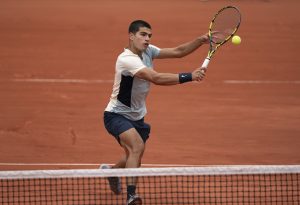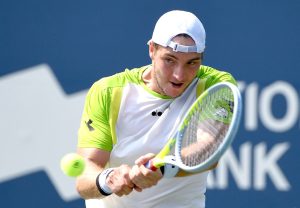As the last few weeks have reminded us, history, which usually unfolds so slowly, can also happen quickly. The last three decades since the collapse of the Soviet Bloc, which had seemed to represent an unending march towards globalisation, now appear, in the wake of Russia’s invasion of Ukraine, to have been a phoney peace before the start of a very hot war. Similarly, in men’s tennis the long-trumpeted era of “The Big Three”, in which Roger Federer, Novak Djokovic and Rafael Nadal seemed locked together in a battle to become the most successful male player of all time, now might just have given way to the era of “The Big One”, in which Nadal alone stands triumphant at the top of the men’s game.
Djokovic Had Appeared To Be “The Big One”
For almost all of 2021, it had appeared that if any one of “The Big Three” was going to break away from the others to assert his dominance, it would be Novak Djokovic. After all, the Serb very nearly achieved the one thing that none of “The Big Three” had ever been able to achieve before – a feat, indeed, that only two men, Don Budge and Rod Laver, have ever achieved in the entire history of tennis – which was to win the Calendar (i.e. actual) Grand Slam.
Throughout 2021, it had seemed almost inevitable that Djokovic would be the man to complete the Calendar Slam, to make it “21 (Majors) in ‘21”. He won in Australia, which he usually does, to start the year, but it was when he beat Nadal in the semifinal of the French Open, in a titanic encounter that may just have been the best men’s match ever played on clay, that his path to total domination seemed clear, especially when Nadal withdrew from Wimbledon. Indeed, the Spaniard, as if licking his wounds after defeat in Paris, barely played again in 2021.
Djokovic duly won Wimbledon, for a sixth time, to bring him level on 20 Majors with Federer and Nadal, and the scene was set for a truly historic occasion in New York last Fall. In the end, however, all the history at the 2021 US Open belonged to 18-year-old Emma Raducanu, who became the first qualifier (either female or male) to win a Major, while Djokovic, as if exhausted by all his monumental efforts throughout the previous nine months, lost rather limply in the men’s final to Daniil Medvedev.
Nevertheless, showing all his typical resilience, Djokovic recovered from that loss to come back strongly at the end of the season, winning the Paris Masters and almost single-handedly leading Serbia to the semifinals of the Davis Cup, at which he played both singles and doubles. Consequently, it seemed that if anyone was going to break the three-way tie at the top of the men’s game and win a 21st Major in 2022, it would be him. But then, as they have done in Ukraine in the last three weeks, things changed.
Federer Was Defeated By Time – Djokovic By Himself
By this stage, nearly four years on from his last Major triumph (in Melbourne in 2018), Roger Federer was very much the third member of “The Big Three”. Having turned 40 last summer, shortly after being bagelled in the third set of his quarterfinal thrashing by Hubert Hurkacz at Wimbledon, it seemed as if all the injuries that the great Swiss had somehow avoided throughout his career had ganged up on him at the end of it. He has barely played at all for the last two years, so his chances of making a sustained comeback, one capable of taking him to another Major, seem negligible.
However, if it was time that defeated Federer, Djokovic effectively defeated himself. He became “No-Vax Djokovic” in Australia for refusing to have a coronavirus vaccination and was duly deported from the country, which denied him the chance to defend his Australian Open title. And lest anyone was in any doubt that he was capable of sticking to his so-called “principles” to the point of absolute self-sabotage, this week he confirmed that he would not be competing in either Indian Wells or Miami, two of the biggest tournaments outside the Majors, because he still refuses to have a Coronavirus vaccination.
Thus, his greatest strength – the sheer, bloody single-mindedness that propelled him from being a child sheltering in the basements of Belgrade during the NATO bombing of the city in 1999 (events he must surely be reliving as Ukraine is similarly ravaged) all the way to the top of men’s tennis – might just also turn out to be his biggest weakness. It is certainly preventing him from competing at the Major tournaments that would allow him to prove that he is, statistically at least, the greatest male player ever.
And so Rafael Nadal, the man who for so long could barely stand on two legs because of all his injury problems, became the Last Man Standing, for the time being at least, among “The Big Three”.
And Even Current World #1 Medvedev Has His Problems
In addition to the misfortunes, self-inflicted or otherwise, that have beset his fellow members of “The Big Three”, Nadal may also benefit from the current predicament of the current world #1, Daniil Medvedev, who overtook Djokovic at the top of the world rankings after Djokovic’s no-show in Australia. Of course, Nadal had already inflicted a grievous blow on Medvedev’s hopes of establishing himself as the natural successor to “The Big Three” by beating him in the Australian Open final in January, after Medvedev had taken the first two sets and appeared to be cruising to his second Major title.
But even that painful loss is probably as nothing to the difficulties that Medvedev is experiencing in the wake of his country’s invasion of Ukraine. This week in Indian Wells, he has openly talked about how much the situation was affecting him, even speculating whether he, like so many other Russian sportspeople, might be banned from playing. At the very least, it is a source of distraction that, like the war in Ukraine, is unlikely to end at any point in the near future.
So, Is A Nadal Calendar Slam Possible?
Consequently, the problems affecting Federer and Djokovic, and the current uncertainty afflicting Medvedev, the only one of the so-called “Next Generation” to have beaten a member of “The Big Three” en route to winning a Major, leave Nadal, for the time being at least, alone at the top of men’s tennis.
Of course, statistically he is now the greatest male player ever, having won that 21st Major in Melbourne. But arguably an even greater prize awaits him this year, especially if his main rivals continue to be beset by difficulties, including some of their own making. That is the Calendar Slam that Djokovic came so close to winning last year.
In one sense, it may seem absurd even to contemplate Nadal winning a Calendar Slam, given the injury problems that he has endured throughout his career, which have often meant that he has been unable to complete a whole season. But now, in his dotage (at least in sporting terms), Nadal can concentrate exclusively on the three remaining Majors this year.
In Paris, Nadal will be burning for revenge against Djokovic for that defeat last year, and in the past he has shown that, on the rare occasions he has lost at Roland Garros, he has come back even stronger the following year. And of course, at the current time, given his ongoing lack of vaccination, there is no certainty that Djokovic, the defending French champion and still Nadal’s biggest rival for the French title, will even appear at Roland Garros. If he doesn’t, then, fitness permitting, Nadal will be a red-hot favourite again to win on the red dirt of Paris.
If Nadal wins in Paris, that would take him halfway to the Calendar Slam and then he would face his biggest test of the year at Wimbledon. However, although he has not won in London since 2010, when he won his second Wimbledon title in three years, he has still gone close in recent years, notably in 2018, when his semifinal defeat to Djokovic was probably the finest men’s match of that year. And having won in Australia this year for the first time since 2009, Nadal has already shown that he is capable of winning a Major that he had not won for more than a decade.
So, if Nadal could win a third Wimbledon title this summer, the scene would be set for New York in the Fall, when he would not only be aiming for a Calendar Slam and a 24th Major in total (to bring him level with Margaret Court as the most successful tennis player ever) but for definitive proof that he is the greatest male player ever.
Of course, all of that is for the future. For now at least, Nadal, who for so long had appeared to be the flakiest member of “The Big Three” in terms of physical fitness, finds himself alone at the peak of the men’s game, and with a unique chance to show that the era of “The Big Three” is over and the era of “The Big One” has begun.
Main photo:
Embed from Getty Images


